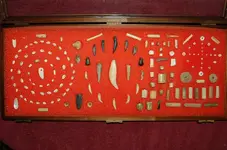The Grim Reaper
Gold Member
- Joined
- Apr 3, 2008
- Messages
- 7,805
- Reaction score
- 7,068
- Golden Thread
- 0
- Location
- Southern Ohio
- Primary Interest:
- All Treasure Hunting
Hey guys, I don't how many of you have collections of Bone and Shell items but if you do you need to heed this warning.
If you have Bone and Shell items in trays using the colored foam backing that comes in all different colors then get them out of there ASAP. I just found out the hard way that this foam eventually starts to deteriorate and as it does it adheres itself to the Bone and Shell artifacts. I was going to rearrange one of my older trays of Ft Ancient pieces from a site I haven't been able to hunt since 1996 because of a change in ownership and as I was trying to take things out to rearrange them the foam was ripping and coming up with the artifacts. I haven't taken everything out so far so I really don't know the extent of the damage and I hope beyond all hope that this stuff comes off these pieces without damaging them. I'm not sure about how it reacts with flint items, but I am going to check all of those trays as well and see how they look. I bought some nice red material from WalMart and I am going to change out the foam in every tray that has any Bone or Shell items and everyone else should do the same before this happens to you.
This is the tray I'm referring too and as you can see there are some really nice pieces in there. Wish me luck. I hope everything is okay. I would be seriously bummed if any of these pieces are permanently damaged.
If you have Bone and Shell items in trays using the colored foam backing that comes in all different colors then get them out of there ASAP. I just found out the hard way that this foam eventually starts to deteriorate and as it does it adheres itself to the Bone and Shell artifacts. I was going to rearrange one of my older trays of Ft Ancient pieces from a site I haven't been able to hunt since 1996 because of a change in ownership and as I was trying to take things out to rearrange them the foam was ripping and coming up with the artifacts. I haven't taken everything out so far so I really don't know the extent of the damage and I hope beyond all hope that this stuff comes off these pieces without damaging them. I'm not sure about how it reacts with flint items, but I am going to check all of those trays as well and see how they look. I bought some nice red material from WalMart and I am going to change out the foam in every tray that has any Bone or Shell items and everyone else should do the same before this happens to you.
This is the tray I'm referring too and as you can see there are some really nice pieces in there. Wish me luck. I hope everything is okay. I would be seriously bummed if any of these pieces are permanently damaged.
Attachments
Upvote
0






